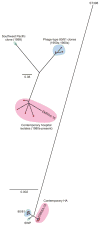Evolution of community- and healthcare-associated methicillin-resistant Staphylococcus aureus
- PMID: 23648426
- PMCID: PMC3884050
- DOI: 10.1016/j.meegid.2013.04.030
Evolution of community- and healthcare-associated methicillin-resistant Staphylococcus aureus
Abstract
Staphylococcus aureus is a prominent cause of human infections globally. The high prevalence of infections is compounded by antibiotic resistance--a significant problem for treatment. Methicillin-resistant S. aureus (MRSA) is endemic in hospitals and healthcare facilities worldwide, and is an increasingly common cause of community-associated bacterial infections in industrialized countries. Although much focus is placed on the role of S. aureus as a human pathogen, it is in fact a human commensal organism that has had a relatively long coexistence with the human host. Many S. aureus infections can be explained by host susceptibility or other predisposing risk factors. On the other hand, the emergence/re-emergence of successful S. aureus clones (referred to as epidemic waves) suggests a rapid bacterial adaption and evolution, which includes the emergence of antibiotic resistance and increased virulence and/or transmissibility. It is within this context that we review our understanding of selected S. aureus epidemic waves, and highlight the use of genome sequencing as a means to better understand the evolution of each lineage.
Keywords: Antimicrobial resistance; Epidemic; Genome sequencing; MRSA; Staphylococcus aureus.
Copyright © 2013 The Authors. Published by Elsevier B.V. All rights reserved.
Figures

References
-
- Adhikari RP, Cook GM, Lamont I, Lang S, Heffernan H, Smith JM. Phenotypic and molecular characterization of community occurring, Western Samoan phage pattern methicillin-resistant Staphylococcus aureus. The Journal of Antimicrobial Chemotherapy. 2002;50:825–831. - PubMed
-
- Alp E, Klaassen CH, Doganay M, Altoparlak U, Aydin K, Engin A, Kuzucu C, Ozakin C, Ozinel MA, Turhan O, Voss A. MRSA genotypes in Turkey: persistence over 10 years of a single clone of ST239. The Journal of Infection. 2009;58:433–438. - PubMed
-
- Amorim ML, Aires de Sousa M, Sanches IS, Sa-Leao R, Cabeda JM, Amorim JM, de Lencastre H. Clonal and antibiotic resistance profiles of methicillin-resistant Staphylococcus aureus (MRSA) from a Portuguese hospital over time. Microbial Drug Resistance. 2002;8:301–309. - PubMed
-
- Bae IG, Tonthat GT, Stryjewski ME, Rude TH, Reilly LF, Barriere SL, Genter FC, Corey GR, Fowler VG., Jr Presence of genes encoding the Panton-Valentine leukocidin exotoxin is not the primary determinant of outcome in patients with complicated skin and skin structure infections due to methicillin-resistant Staphylococcus aureus: results of a multinational trial. Journal of Clinical Microbiology. 2009;47:3952–3957. - PMC - PubMed
Publication types
MeSH terms
Substances
Grants and funding
LinkOut - more resources
Full Text Sources
Other Literature Sources
Medical

